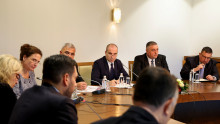Only two bridges connect Bulgaria and Romania along their 475-kilometer shared river border – a transport deficit that functions as a new “Iron Curtain” within the European Union. This was emphasized by Deputy Prime Minister and Minister of Transport and Communications Grozdan Karadjov during a trilateral meeting with Greece’s Alternate Minister of Transport Konstantinos Kyranakis and Romania’s Secretary of State at the Ministry of Transport and Infrastructure Horatiu Cosma.
“If we concentrate all traffic at a single point – in this case Ruse – Giurgiu – we lose the entire capacity whenever congestion occurs along the South-North Axis. This is neither reasonable, nor a sustainable transport architecture. We urgently need at least one more crossing to the east along the river — for example, a bridge between Silistra and Călărași,” Karadjov stated.
He called for accelerated agreements between the three countries to build additional bridge facilities.
“We need to connect Bucharest with Athens and Alexandroupolis with Odessa – that is the common task of our three parties,” he said.
Karadjov also stressed the need for real rather than declarative transport integration:
“We can keep discussing connectivity for decades, but without real projects and actions, it won’t happen. If you go to Călărași and throw a stone, it will land on the Bulgarian bank – that’s how close we are. Yet at the same time, trucks wait for hours to cross the Danube using the only ferry.”
Greek Minister Konstantinos Kyranakis expressed support for the initiative and highlighted the need for short-term action:
“By the end of 2025, there are available European funds for financing. If we manage to develop a joint transport map, especially in the rail sector, we will be able to apply with integrated projects.”
In turn, Romanian Secretary of State Horatiu Cosma noted that the Alexandroupolis – Ruse – Giurgiu – Moldova Corridor is of strategic importance for Bucharest.
“The key issue is financing. We are ready to cooperate for more bridges. We are prepared to discuss the first bridge initially, and then continue the dialogue for additional ones,” he said.
During the meeting, it was agreed that in early November a technical meeting will be held in Thessaloniki between representatives of infrastructure companies from the three countries. The goal is to prepare joint project proposals that, by the end of 2025, will be submitted to the European Commission under suitable EU funding programs.






